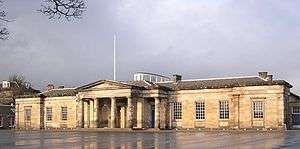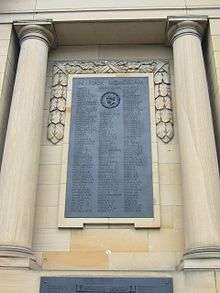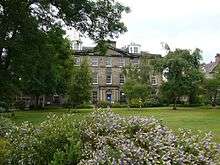Edinburgh Academy
 | |
| Motto | Αἰὲν ἀριστεύειν (Greek) (Ever to Excel) |
|---|---|
| Established | 1824 |
| Type | Independent school |
| Rector | Barry Welsh[1] |
| Founders | Henry Cockburn, Leonard Horner and John Russell |
| Location |
Henderson Row Edinburgh EH3 5BL Scotland |
| Local authority |
Her Majesty's Inspectorate of Education City of Edinburgh |
| Students |
93 (Nursery) 372 (Junior School) 552 (Senior School) |
| Gender | Mixed |
| Ages | 2–18 |
| Houses |
Carmichael Cockburn Houses Kinross |
| Colours | Blue and White |
| HMIE Reports | Report |
| School Song | Floreat Academia |
| Former Pupils | Edinburgh Academicals |
| Website | www.edinburghacademy.org.uk |
The Edinburgh Academy is an academically selective independent school which was opened in 1824 and is now the most expensive day school in Scotland. The original building, in Henderson Row on the northern fringe of the New Town of Edinburgh, Scotland, is now part of the Senior School. The Junior School is located on Arboretum Road to the north of the city's Royal Botanic Garden.
The Edinburgh Academy was originally a day and boarding school for boys. It ceased boarding and transitioned to co-education in 2008 and is now a fully coeducational day school.[2] The nursery, housed in a 2008 purpose built block on the Junior campus, caters for children from 2 to 5. The Junior School admits children from age 6 to 10 whilst the Senior School takes pupils from age 10 to 18.
Foundation
In 1822, the school's founders, Henry Cockburn and Leonard Horner agreed that Edinburgh required a new school to promote classical learning. Edinburgh's Royal High School provided a classical education, but the founders felt that greater provision was needed for the teaching of Greek, to compete with some of England's public schools. Cockburn and Horner recruited John Russell as a co-founder and the three of them, together with other interested parties, put a proposal to the City Council for the building of a new school. The City Fathers gave their approval in 1823 and fifteen Directors were elected, comprising the three founders and twelve other luminaries, including Sir Walter Scott, Sir John Hay and Robert Dundas.
Buildings


The main building of the Senior School, with its Greek Doric frontage, was designed by architect William Burn.[3] The stone used was principally from the nearby Craigleith Quarry. The Foundation Stone was laid in June 1823 and the school opened for the first session in October 1824. In 1892, new classrooms were built along the western wall of the site, and in 1900, the School Library was opened, followed by the new Science Block in 1909, both along the eastern wall. At the back of the school the Dining Hall, and the Rifle Range beneath it, was opened in 1912 and after World War I, the Gymnasium was built. This was dedicated as a War Memorial to Edinburgh Academicals (former pupils) who had fallen during the hostilities of 1914 to 1918.[4] The memorial was by Pilkington Jackson. A later plaque commemorates ex-pupils who fell in the Second World War.
In 1945, a new building, Denham Green House, was acquired in the Trinity area of Edinburgh. This was used for the junior department (now known as Early Years) of the Preparatory School (now known as The Edinburgh Academy Junior School). In 1960, a new building for the upper three years of the Preparatory School was completed in Inverleith (Arboretum campus). Denham Green's nursery and early years facilities were relocated to purpose built accommodation on the Preparatory school's Arboretum campus in 1987. In 1992, the Rector's residence, Academy House and in 1997, a new Games Hall were constructed on the same campus. The latter was partly funded by money from The Lottery and Sports Council and is for the use not only of pupils in both parts of the school but also of the community in the area. A new computing and music building was completed at the Junior School in 2005 and a new nursery and after school facility in 2008.
At Henderson Row, the property next to the school, No 32, was acquired for administrative use in 1972 and in 1977, the Academy acquired the junior school of Donaldson's College, to the west. This allowed departments to expand and a purpose built Music School was opened on this part of the campus in 1991. In 2005 the 1909 science block was demolished and a new science block, the James Clerk Maxwell Centre, named in honour of the 19th century scientist and former pupil, was opened on 3 November 2006 by Lord Falconer of Thoroton.[5]
Controversies
Since 2000, there have been serious allegations of bullying.[6]
More recently, allegations of bullying resurfaced when fellow students were physically abused by older pupils during a Combined Cadet Force camp in 2014.[7] Allegations of the sale of drugs amongst 13-year old pupils also made the headlines in the same year.[8] In 2015, it was revealed that police were also investigating claims made by pupils from further back of alleged sexual abuse by staff members in the 1970s.[9]
Former pupils have been investigated for allegations of abuse which led to a tragedy.[10] In 2017, the school was under controversy for an organised 'fight club' which involved up to 50 pupils.[11]
Notable alumni
Alumni of The Edinburgh Academy are known as Academicals, or Accies, a name shared with the Rugby team.
Famous alumni of the school include Robert Louis Stevenson, James Clerk Maxwell, Magnus Magnusson, Baron Falconer of Thoroton and Mike Blair. It has also produced one Nobel Prize winner, numerous political and legal figures, several rugby internationals and seven recipients of the Victoria Cross - the highest number of any school in Scotland. According to the Sutton Trust, the school is placed second in Scotland and joint 36th in the UK for the number of the nation's leading people produced.[12]
Rectors of The Edinburgh Academy
There have been 18 rectors of The Edinburgh Academy since it was founded in 1824.[4]
- 1824-28: John Williams
- 1828-29: Rev Thomas Sheepshanks
- 1829-47: John Williams, again
- 1847-54: Rev John Hannah FRSE
- 1854-69: Rev Dr James Stephen Hodson FRSE
- 1869-88: Thomas Harvey FRSE
- 1888-1901: Robert Mackenzie
- 1901-10: Reginald Carter
- 1910-26: Robert Ferard
- 1926-31: Hugh Lyon
- 1931-45: Lionel Smith
- 1945-51: George Semen
- 1951-62: Robert Watt
- 1962-77: Herbert Mills
- 1977-92: Laurence Ellis
- 1992-95: John Rees
- 1995-2008: John Light
- 2008-2017: Marco Longmore
- 2017-present: Barry Welsh
See also
References
- ↑ "Rector's Welcome".
- ↑ "Edinburgh Academy to stop taking boarders in £5m revamp". Herald Scotland. 29 March 2007.
- ↑ Cosh, Mary (2003). Edinburgh:The Golden Age. John Donald. p. 659. ISBN 978-1-78027-258-0.
- 1 2 "History of the School". Edinburgh Academy.
- ↑ "opening of James Clerk Maxwell Centre". Edinburgh Academy.
- ↑ "Teachers at top school accused of bullying colleagues and pupils". The Scotsman.
- ↑ "Army camp assaults on Edinburgh Academy pupils probed". BBC News.
- ↑ "Private school suspends pupil over 'drug sale'". Edinburgh Evening News.
- ↑ "Police probe sex abuse claims at Edinburgh Academy".
- ↑ "University expels Angus Milligan after abused girl Emily Drouet's death". The Times.
- ↑ Jolly, Bradley. "Pupils brawl in bare-knuckle 'fight club' at £14,000-a-year private school". Metro.
- ↑ "The Educational Backgrounds of the Nation's Leading People" (PDF). Sutton Trust. November 2012.
- Magnus Magnusson (1974), The Clacken and the Slate, Collins, London. ISBN 0-00-411170-2
- Edinburgh Academical Club (1995), List of Past and Present Pupils 1824-1995, Edinburgh Academical Club
- Stirling, Bill (1999), 175 Accies, Edinburgh Academical Club